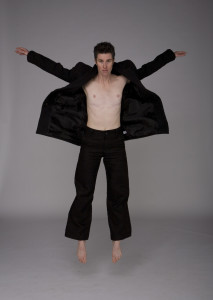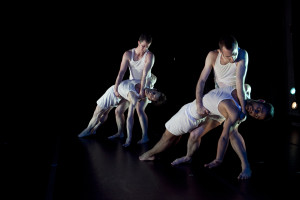San Francisco’s Sean Dorsey Dance has racked up a nice trophy case: a Goldie, a pair of Izzies, a “Best Dance-Performance Company” nod from SF Weekly, a 2010 Dance Magazine “25 to Watch,” and major national commissions for The Secret History of Love, a groundbreaking dance-theater production about the life experiences of LGBT people in decades past, and how those courageous elders found love against sometimes terrifying odds.
But the secret of Secret History is that it’s about all of us: our vulnerability, our deep need to connect and the risks we take to do so, how we’re all in the same rickety little boat, hoping to navigate to safe harbor. It’s also about well-constructed dance, compelling storytelling and laugh-out-loud humor.

Photo by Lydia Daniller
Dorsey spent two years interviewing elders across the U.S. and perusing archives to garner material for the show, which incorporates contemporary dance, spoken word, voiceovers and live music. Performed by Dorsey, Juan de la Rosa, Brian Fisher, Nol Simonse and Shawna Virago, Secret History premiered at Dance Mission Theater in March 2012. Then the company piled into the Sean Dorsey Dance Family Van for a nine-city tour that succeeded far beyond their expectations.
The show returns to Dance Mission March 28–31 before heading out on a fifteen-city tour. It turns out that America can really relate to Secret History. Dorsey sat down with Claudia Bauer to talk about how queer, and how wonderful, that is.
CB: Secret History is not the typical dance performance. How were you received?
SD: We visited an incredible range of cities, from downtown Miami to rural Wisconsin. We were so blessed to visit a real range of communities, some of whom are steeped in amazing access to dance and art and culture and LGBT community, and some of whom have literally no access to LGBT arts and very little community support.
CB: Did you feel in danger at all?
SD: We were definitely aware of our safety. Everyone in the company is LGBT, and so we were conscious of ourselves as pretty visible. But it was also amazing—walking into a small-town restaurant where the flamboyant gay waiter came to our table. It made me so mindful of how, despite the daily threats of violence and economic marginalization so many trans people still live with in the Bay Area, how much of a beautiful pink bubble we live in here. In Whitewater, which is in rural Wisconsin—Romney signs everywhere—when we got to the theater I said to the company, “We may have forty or fifty people show up, and that is okay because this work is important and beautiful. Know that those forty or fifty people in this thousand-seat theater are going to really connect with the work and take it home with them.” And then we had 500 people come, which was absolutely mind-blowing.
CB: Do you think they were drawn by contemporary dance or by the LGBT theme?
SD: Both. There were young queer people, young trans students, there were middle-aged straight dance enthusiasts. After the show all kinds of people lined up to talk to us, including a young straight couple who came up to me, and the guy, kind of a jock, said, “My girlfriend is interested in dance, and this was the first dance show I’ve ever seen. Thank you, this was really cool and interesting and powerful.” That’s so beautiful, to have people who I would never expect to wait in line to give us feedback and love.
CB: My sense is that anyone who is in touch with that vulnerable part of themselves can relate to Secret History.
SD: I think that’s why the young transgender person who has never seen dance before will respond to the work just as strongly as the person who doesn’t know any trans people at all. My ultimate goal is for the work to be really human and universal—about our fears of being different or of isolation or taking risks, the vulnerability of relationships. We all feel that.
CB: Boston was a huge moment for you, because that’s where this all began.
SD: I’d worked with Boston elders’ life stories and voices for two years by the time we returned for the East Coast premiere last May. Many of those elders attended the show, and for us there was a great anticipation and excitement, and also some anxiety: Did we do these people’s stories and lives justice? It’s such an incredible responsibility to first witness and hold someone’s life story, struggles and joys and pains, survival—and then to embody it on stage.
The theater sat about 200 people, and all four shows sold out. At every show there was at least one elder who was a part of the oral history project, and we would invite them up for the bows. They were all in tears, and every single elder expressed that they felt that their story and their voice was so deeply honored; I am proud of that. These elders are the ones who opened the doors, endured police harassment, sexual assault and beatings and bar raids, lost custody of their children, survived horrors…but they also fell in love, organized, started the bathhouse scene, sparked the sexual revolution, accomplished so much. Our culture dismisses our elders, desexualizes them, stops listening to them and taking them seriously. So these elders felt that their struggles and victories were finally being seen. The core theme of the show is that despite all the struggle and pain, human beings still have a capacity for joy, love, beauty, healing, resilience, adventure.
CB: That strength to keep trying is profoundly moving. I don’t know where that courage comes from.
SD: Even though there are more school-based support groups in larger cities than ever before, in every single city that we toured to, we still heard LGBT youth say, “This is the first time I’ve seen someone like me onstage.”
CB: Why is it important to see ourselves reflected in culture?
SD: Art allows us to dream and imagine our futures. It feeds us and sparks our hunger for beauty and justice. Seeing ourselves in culture is affirmation that we exist, that we matter; when we’re excluded from it, it sends us a very strong message that we don’t matter and that our bodies aren’t beautiful.

Photo by Lydia Daniller
CB: How does Secret History address that?
SD: Showing LGBT people that they are part of a lineage of powerful, strong, daring, loving people and ancestors who made our lives possible is a very powerful thing. Most of the time, transgender and queer people never, never, never get to see themselves reflected in culture. And if we ever are represented, we are pathologized. Much of the country hasn’t thought about that reality.
CB: You did a lot of outreach on the tour as well.
SD: Whenever we tour we do a residency, which might include teaching dance classes or leading a community conversation or a panel on arts and social justice. One of my favorite things to do in these residencies is a dance workshop that welcomes absolutely terrified beginners and that is transgender-friendly and queer-friendly. Almost all transgender people will never set foot in a gym or a yoga studio or a dance studio because it is profoundly unsafe and unwelcoming for them, so being in a room full of people who are able to access physical expression for the first time, and then dancing my choreography together, always brings me to tears. It feels absolutely, spectacularly amazing.
CB: So now Secret History returns to San Francisco. Is it the same show, after all these experiences?
SD: I feel like the work is inhabited now by so many more people who the work touched over the past year. It feels like this jam-packed, buzzing room full of voices now in the work. Brian, Nol, Juan and Shawna are all such brilliantly gifted performers, and we all had such profound experiences on tour this year. The emotional response that the work has gotten is going to inhabit and charge the work and its gesture and touch and partnering in a new way…all those things get embodied in the dance, and the show evolves.
CB: What has this meant to you as an artist, as a person?
SD: Getting to sit across a table from transgender and queer elders across the country and experiencing their generous vulnerability and openness about their life histories, and to have such amazing dancer-performer collaborators, is such a gift. When I researched in the archives, I put my hands on people’s real love letters, even love notes on cocktail napkins. What inspiration! The project also kicked my ass and pushed me in a lot of ways, and absolutely changed my life and my career. It brought national visibility and acclaim for my work. We have tours booked through 2014! It has been a life-changing blessing.
CB: What’s next?
SD: I’m launching my new project, The Missing Generation and the Source of Joy. What became painfully clear in my last process were all the voices that were absent, all the people we lost to AIDS who would have been my elders, my teachers, our friends and peers and lovers. To create the show I will jump back into archival research, and I am launching an LGBT Intergenerational Oral History Project in which I will bring youth and elders in conversation with each other.
Starting in the 1950s, Drag Mothers, Butch Dads and the Ball scene’s House Mothers played such an important familial role for youth and provided mentorship, support, housing, lifesaving relationships…and all this changed so radically when we lost much of an entire generation to AIDS. We’ll premiere part one of the show in March 2014. I’m very excited about this project.
So get ready, rural Wisconsin… here they come.
The Secret History of Love performs Thu-Sun, March 28-31 at Dance Mission Theater, SF.
This article appeared in the March 2013 issue of In Dance.

